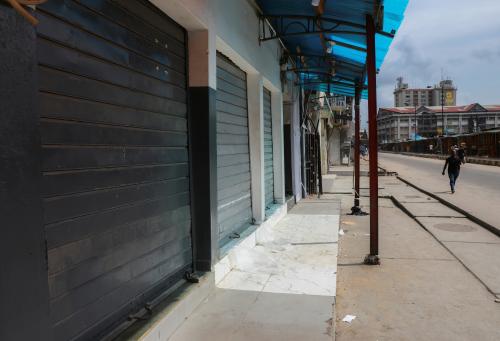Recent global trends like the COVID-19 pandemic, the climate change crisis, and heightened trade disputes among the world’s leading trade partners have highlighted the vulnerability of global value chains (GVCs). At present, the scale of the disruption in East Africa is quite dire—imports from China (a common source of intermediate goods) through the Mombasa Port declined by a drastic 20 percent shortly after the onset of the pandemic, between January and February 2020.
In light of these trends, governments and industries in East Africa should consider rapidly shifting from focusing on global value chains (GVCs) to regional ones (RVCs). Given the region’s past difficulties with entering global value chains and consolidating the gains from regional integration processes, heightened emphasis on regional value chains could reap compounding benefits. The time is ripe: As documented in our recent report, the recently signed and ratified African Continental Free Trade Area (AfCFTA) can be the great enabler of that shift.
The stagnation in GVCs
The literature on GVCs emerged in the 1990s, after which the development community began to frame development success in terms of the ability of countries to insert themselves into these GVCs. Although not uncontested, academic research provided evidence of the benefits to workers and improved prospects for poverty reduction from participating in GVCs. However, the current shortcomings of GVCs predate the COVID-19 crisis. Indeed, ever since the global financial crisis of 2008-2009, GVCs seem to have lost their momentum (Figure 1).

The reasons are complex but tied up with the post-2009 slowdown of global growth and investment, as well as the stalling of multilateral trade liberalization. Moreover, many GVCs have already matured, making further specialization challenging and creating additional difficulties for developing countries to enter those value chains. By contrast, intra-African trade, albeit at a low level, has been buoyant and rising rapidly since the global financial crisis (Figure 2).

Explanations for the failure to integrate into GVCs
Against this backdrop, it is essential to understand why, beyond the provision of raw materials, a limited number of low value-added textile exports, and horticultural products, East African countries have struggled to insert themselves into GVCs. The reasons for this are multiple—some of them self-inflicted (e.g., a lack of productive efficiency). In other cases, however, East African countries are blameless. In some instances, their products have fallen foul of excessively demanding phytosanitary standards. Another cause has been the withdrawal or suspension of preferential market access, e.g., in 2018 when Rwanda banned the import of secondhand clothing and subsequently was suspended from specific provisions of the African Growth and Opportunity Act (AGOA), the U.S. law encouraging market access for African countries. In still other cases, harsh rules of origin have undermined the value of preferential market access.
The urgent need for a new approach to increase African participation in regional value chains
Beyond the historic difficulties experienced by African countries in inserting themselves in GVCs and the current disruption caused by the COVID-19 crisis, we can point to several reasons for a new and urgent strategic approach for regional value chains:
- Environmental costs. The long-distance transport of intermediate goods by ship or air inevitably imposes a significant environmental footprint. Some of the current supply chains are overly complicated—and the resulting carbon emissions are substantial. For instance, Kenyan textile exports, often with intermediate inputs supplied from India, are shipped out to the U.S. market under the provisions of AGOA, only to be exported back as secondhand clothing. By contrast, geographical proximity means that RVCs, as opposed to GVCs, have the potential to reduce, if not abate, the transport-related carbon emissions, which is a topical subject in the region. A shift to regional value chains could also reenergize the languishing regional textile industry.
- Acceleration of structural change and diversification. Reflecting the failure to integrate into higher stages of GVCs, East African Community trade with advanced economies in the global north and Asia consists of over 80 percent raw materials and unprocessed goods. By contrast, around half of all the regional blocks’ intra-regional exports are manufactured goods. Especially after the implementation of the AfCFTA, the African market offers a great hitherto unexploited potential, particularly for the development of intra-regional value chains. Thus, to substantially change and diversify the economic structure while encouraging the industrialization of East African economies, the regional route, not the global one, is more expedient.
- Greater economic resilience. The COVID-19 crisis has exposed the degree of dependence on international markets in some key export sectors. For example, the Kenyan flower industry has succumbed to COVID-19 due to demand contraction in European markets. By contrast, regional markets in East Africa have a resilience the global ones often lack, primarily due to geographic proximity. Thus, for example, when Kenya suffers drought, neighboring Ugandan or Tanzanian farmers tend to pick up the slack and start exporting more to Kenya. These patterns of trade can be highly beneficial for individual economies too: Uganda’s intra-regional trade, for instance, has recently been surpassing that of Kenya’s (the region’s largest economy), principally thanks to its role as a supplier of agricultural produce to its neighbors.
In summary, we believe developmental and policy discourse has been skewed excessively towards equating “export success” with the ability to integrate into GVCs and sell products in high-income country markets. Policymakers in East Africa have, for a long time, embraced such policy strategies. In turn, the region has become more exposed and prone to GVC-related shocks, as seen with the onset of the current COVID-19 crisis. A more rapid expansion of regional trade, by contrast, is arguably the surest and safest way to diversify trade and reduce vulnerability, with the added plus that it is kinder on the environment.








Commentary
Trade in uncertain times: Prioritizing regional over global value chains to accelerate economic development in East Africa
April 15, 2020